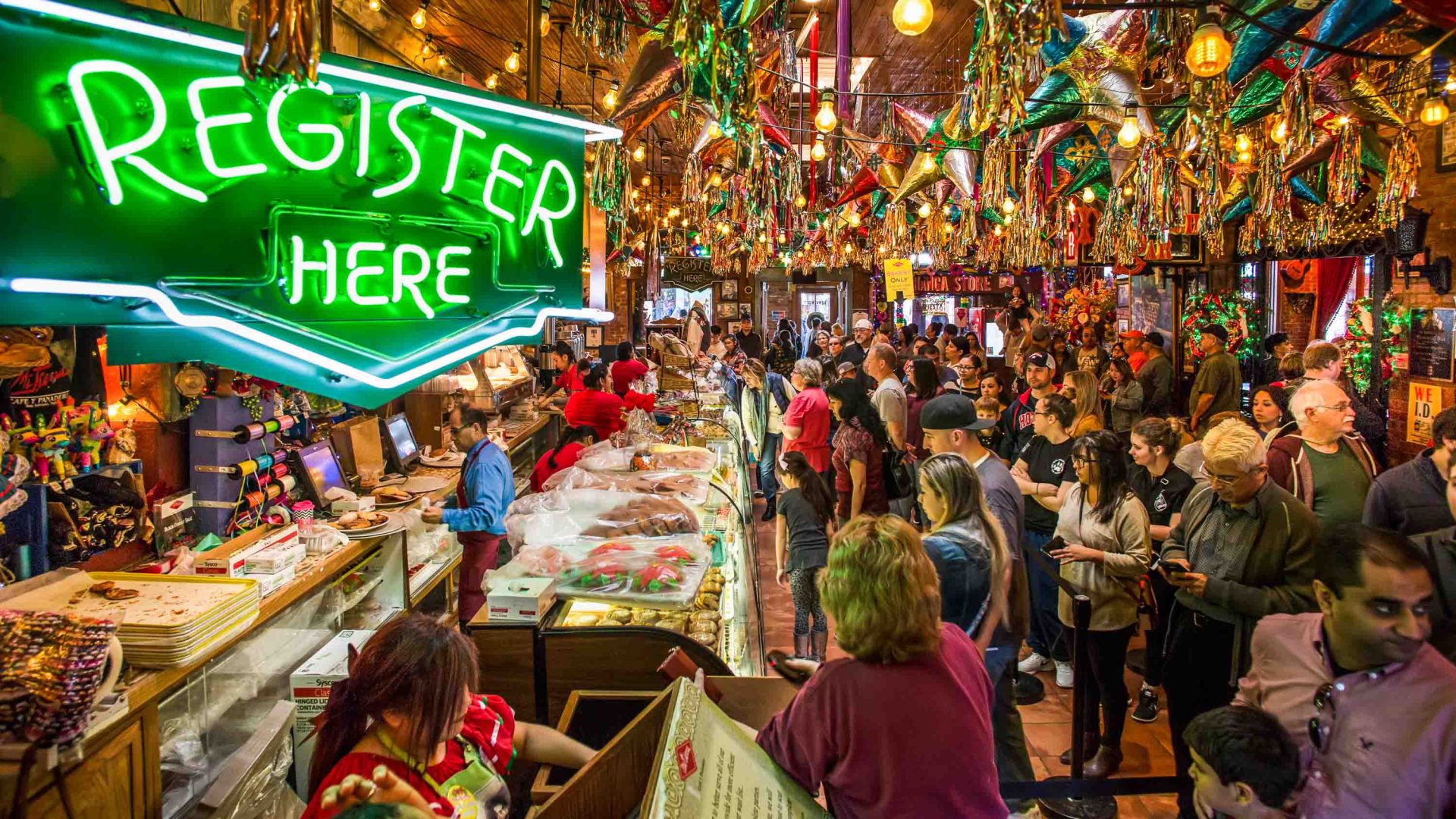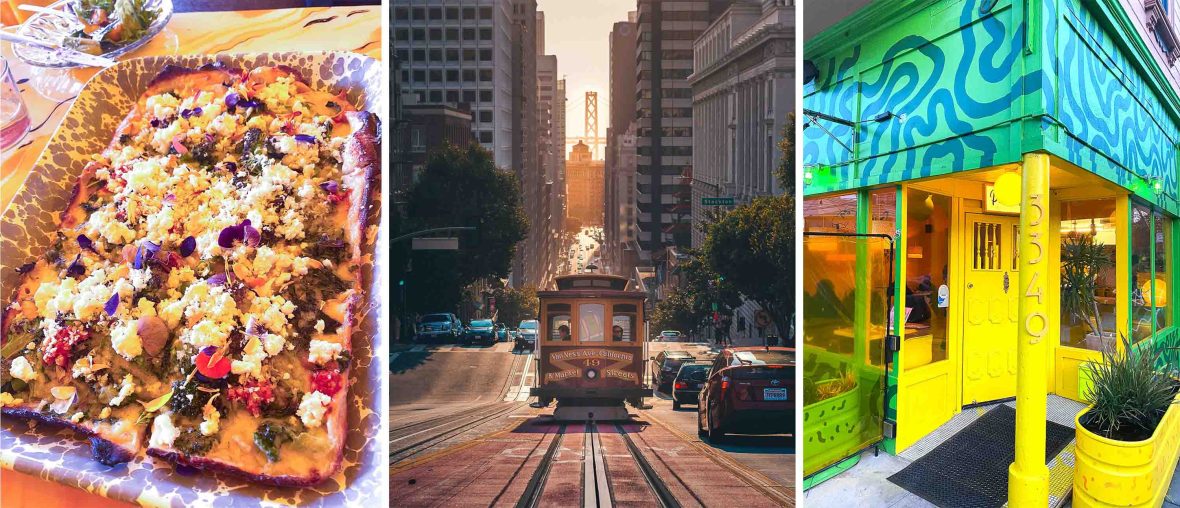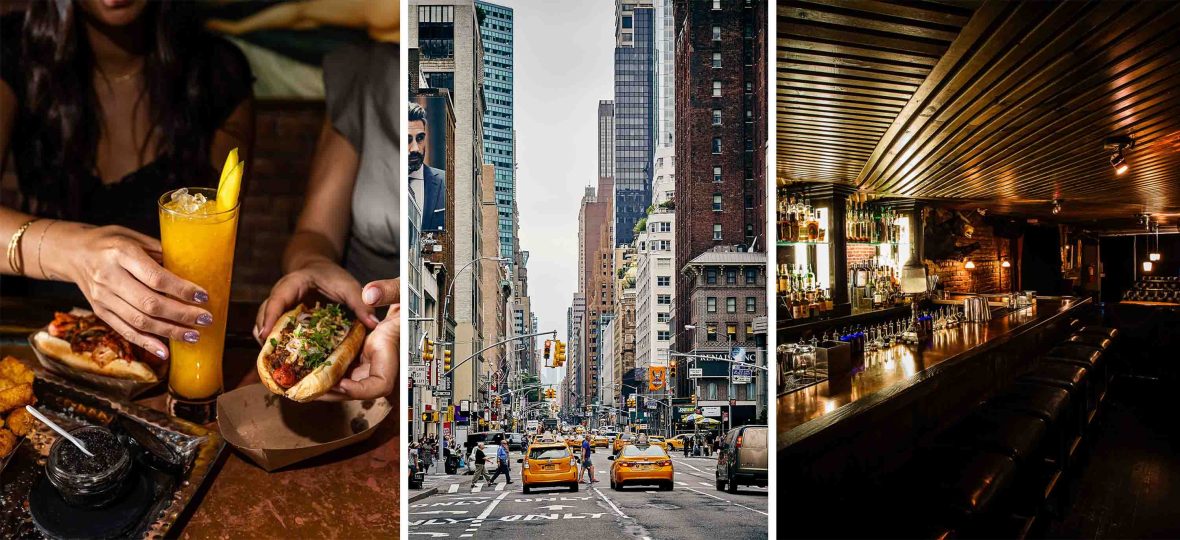
In downtown San Antonio, Texas, a 500-seat restaurant is decorated with bright Christmas lights and tinsel trees—all year long. Jo Fernandez pays a festive visit—off-season—and shares six more themed restaurants and venues around the US.


In downtown San Antonio, Texas, a 500-seat restaurant is decorated with bright Christmas lights and tinsel trees—all year long. Jo Fernandez pays a festive visit—off-season—and shares six more themed restaurants and venues around the US.
There can’t be many restaurants decked out like it’s Christmas every day. But that’s what it’s like at Mi Tierra Café Y Panadería in the Texan city of San Antonio, festooned with strings of twinkling, technicolor holiday lights, streamers and tinsel Christmas trees—every single day of the year.
As I walk into the restaurant on Market Square, the largest Mexican market in the United States, I’m immediately immersed in a world of multicolored Mexican—and, surprisingly, traditional Christmas—decorations. In the entrance is an ornate ofrenda, a mass of glittery blue-hued fake poinsettias, statuettes and candles honoring deceased locals and staff, and every inch of the place is covered with piñatas and star-shaped papel picado (punched paper).
As the sweet aroma of freshly baked pan dulce (Mexican pastries) hits me, I’m hooked. As an aficionado of all things Mexican, it feels festive and cultural, rooted in Latino and Tex-Mex traditions, but with a huge helping of festive kitsch.
I meet Pete Cortez, grandson of founders Pedro and his wife Cruz Cortez, who opened Mi Tierra in 1941. Pedro left his native Guadalajara in western Mexico during the Great Depression of the 1930s, moving to Texas to find work. From the tiny three-table workers’ café, Pedro and Cruz moved on to a bigger venue, changing the name to Mi Tierra.
Now CEO, Pete tells me how the restaurant, which grew so rapidly it now seats 500 people, came to be so festive every day. “By the late ’60s, we were so busy preparing for the 1968 World’s Fair, that by the time we could take down the Christmas lights, it was time to decorate again,” he says. “Since then, the tradition has only grown. They [the lights] made the restaurant feel festive year-round and brought joy to our guests, representing the warmth of our culture and hospitality.”
As well as the ofrenda, piñatas and papel picado, Mi Tierra pays homage to the Mexican tradition of murals, and a ‘Who’s Who’ of prominent Mexicans covers an entire wall. I spot as many as I can before heading for breakfast among the tinsel Christmas trees overloaded with shiny red baubles, from revolutionary Pancho Villa to artist Frida Kahlo and Breaking Bad actor, Giancarlo Esposito.
Two elderly mariachis stop and serenade me at the table as staff in traditional folk dresses bring sizzling plates of fried potatoes and eggs, smoky refried beans and slow-cooked beef barbacoa (seasoned, tender shredded beef). Pete smiles: “The food we serve, from classic San Antonio Tex-Mex to regional Mexican dishes is a blend of cultures, flavors and generations—just like our city.”
Embracing my fondness for themed restaurants and foodie attractions in the US, I went in search of a few more, from intergalactic speakeasy bars to ‘spiritual’ spaces and a food history-themed museum.
When you enter this neon-lit space. you’re stepping into a tropical galaxy where a space ship has just crash-landed into a volcano. The interior of this San Diego star is all about the detail, from the blue rock formation on the back of the hidden entrance door in a former cantina to the color-changing lights and the bar that resembles a spaceship control board.
Suitably themed drinks include the Caribbean rum-drenched Away Mission and the non-alcoholic Tang & Tonic (Tang-flavored crystals and Indian tonic water). So meticulous is the Mothership concept, there’s even an original space-rock soundtrack by local composer Justin Pinkerton to accompany the experience (available on vinyl, online).
Flick through the menus—designed like flight manuals—and choose from fusion small plates featuring innovative vegan combos such as latke (potato fritter in Ashkenazi Jewish cuisine) with kimchi cream cheese, nasturtium leaf and Persian cucumber, and bao buns filled with smoked achiote jackfruit, cilantro and caramelized pineapple.

Settling into the far-out furniture at Shuggies‘ 1970s-inspired orange dining room, including plastic chairs with legs resembling humans, feels more eccentric than eco. This fall (subs: 2025), the owners upped the kitschy vibe, adding glittery banquettes under a disco ball where diners can sit and enjoy a more sophisticated supper-club vibe, complete with live jazz performances.
Yet, sustainability remains at the heart of this Mission District climate-positive space once famed for ‘trash’ pizzas made from surplus and imperfect produce. The more grown-up menu—although there isn’t one listed online to allow for seasonal, market-led dishes—features tuna rib crudo made with fish parts that would normally be wasted, spiced up with green-curry aioli and pickled chiles.
Sip a glass of Sister Louisa’s spiritual sangria or a rum and cherry-soda-infused blood of Christ as you behold the spectacle of this one-of-a-kind church-themed bar in Atlanta’s historic Old Fourth Ward—most notable as Martin Luther King Jr.’s childhood neighborhood.
Here, in what passes as a church from the outside, you’ll find a pulpit, crucifix lampshades, neon angels and all manner of religion-inspired art by Sister Louisa, the pseudonym of the deacon-turned-antiques collector owner. After a stint as a bartender, he opened the bar to showcase his antiques and art collection, and he now hosts everything from wholesome ping-pong tournaments to tarot card readings and church organ concerts.
Resembling a tropical resort, complete with a beach house upstairs and a mysterious cave downstairs—not to mention waterfalls, totems, and giant shareable pu pu platters (a tray of American Chinese or, in this case, Polynesian appetizers) of coconut shrimp, mochiko (sweet rice flour-coasted) chicken wings, yokozuna ribs, crab lagoon dip and house pickles—it’s easy to forget you’re at a tiki bar next to a gas station on South Lamar, the main thoroughfare that runs through the neighborhood of the same name.
In this casual spot, Tokyo-born and Texas-bred owner Tatsu Aikawa has brought ramen culture and informal izakaya-style dining to Austin. Fantastical punchy cocktails served in OTT-tiki mugs include the Slurping Bastard, concocted with gin, shōchū (a strong Japanese distilled spirit), brandy, bitters, ginger, cherry and ume shrub (sometimes called Japanese apricot or Chinese plum), and Painkiller, with rums, shiro-miso coconut cream, pineapple and tangerine. Enjoy them alongside a menu awash with easy-to-eat dishes such as papaya tempura with tentsuyu, a sauce made with dashi, mirin and soy – yuzu salt and ginger or a spam musubi (rice ball) with pineapple teriyaki jam.

Locals and the odd tourist seeking a dark and secret space for expertly crafted cocktails frequent this East Village prohibition-inspired, speakeasy-style bar—that’s tucked inside Crif Dogs hot dog joint.
To get in (reserve online), you need to enter through an old-school phone booth in the back of Crif Dogs. Next, dialing 1 on the vintage red plastic wall-hung rotary phone on the secret door reveals a tiny wooden-ceilinged, taxidermy-strewn space.
Once the hostess has let you in, you’ll be sat at one of the scattered tables or at one of 15 leather-topped stools at the bar, where you can watch staff whisk up concoctions such as The Shark with Wray & Wray rum, Frangelico and butter-infused Bacardi Silver rum. And if you get peckish, it’s bacon-wrapped, deep-fried creative Crif Dogs with added bacon, cheese or onions all the way.
New York City doesn’t lack museums and places to eat, but there’s one attraction that combines both. At this non-profit Brooklyn museum in Dumbo, visitors can explore the rich intersections of food, culture and science.
MOFAD’s motto—’Food is Culture’—hints at the exhibits you can see, taste and touch, often involving live chef demonstrations and talks. This year, MOFAD hosted a special exhibition called Flavor!, designed and curated by food scientists and culinary anthropologists, explored what happens in our brains when we taste food. Previous exhibitions explored the Black community’s contribution to America’s cultural and culinary landscape, which included tasting menus served in shoeboxes, a symbol of how Black people had to eat on the move in the Jim Crow era while Cookbook Corner is a permanent collection of over 4,000 cookbooks donated by philanthropist Joanna S. Rose, which visitors can visit by appointment.
The next exhibition is Street Food City, opening in December, which will celebrate the immigrant street food entrepreneurs and small food businesses who have shaped the food scene and culture of New York City, while also charting the challenges faced by street vendors right up to today’s current fight for vendor rights.
And if an exhibition doesn’t involve tasting, you won’t go hungry—MOFAD is housed within the 24,000-square-foot Time Out Market, a fiesta of classic New York CIty flavors, from Bark Barbecue, a food stand serving up Dominican flavors cooked with Texas techniques to Dughonuttery, renowned for its innovative and traditional mini doughnuts, and southern comfort food haven Jacob’s Pickles which serves up classics such as buttermilk fried chicken and mac-and-cheese, and, of course, pickles.
****
Adventure.com strives to be a low-emissions travel publication. We are powered by, but editorially independent of, Intrepid Travel, the world’s largest travel B Corp, who help ensure Adventure.com maintains high standards of sustainability in our work and activities. You can visit our sustainability page or read our Contributor Impact Guidelines for more information.

After two decades at London newspaper Evening Standard, Jo Fernández became a freelance travel writer. She particularly loves Latin America, the Caribbean and Spain, and has a book on tapas in Madrid pending publication. She recently moved back to East London after a lengthy stint in the eastern English county of Essex, and edits a website devoted to the two: I Love Essex & East London.








Can't find what you're looking for? Try using these tags: